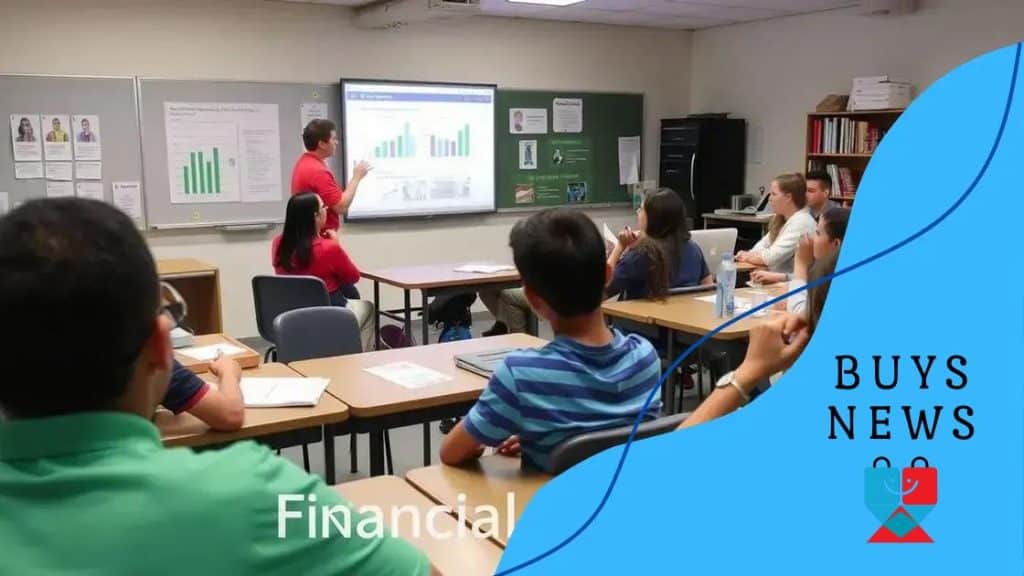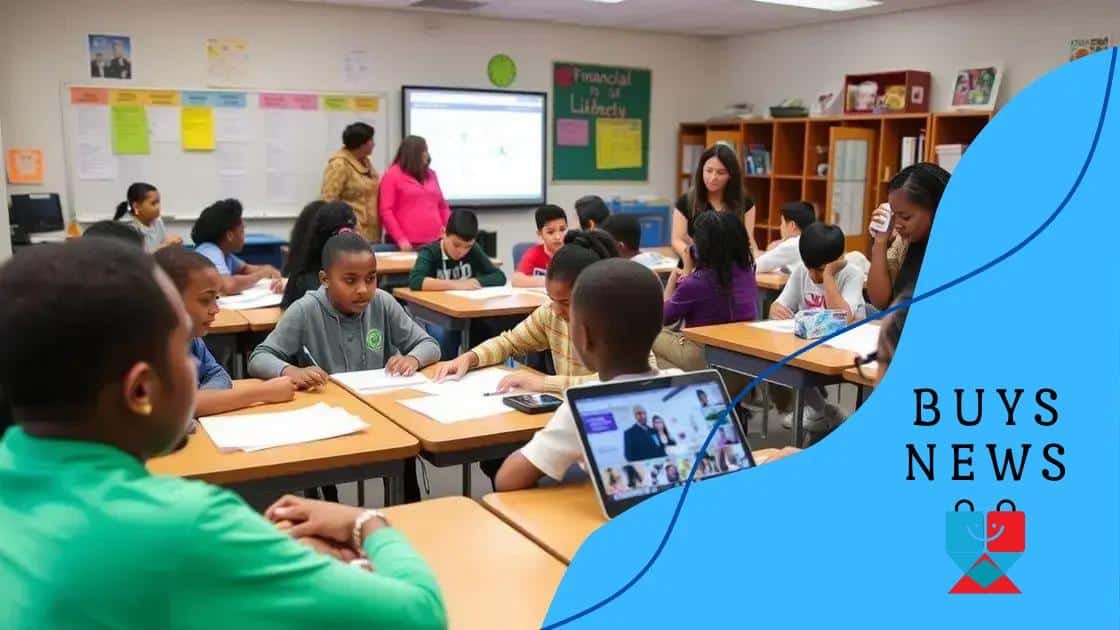Financial literacy curriculum development: a guide to success

Financial literacy curriculum development focuses on equipping students with essential financial skills like budgeting, saving, and investing, enabling them to make informed financial decisions throughout their lives.
Financial literacy curriculum development is more important than ever. With mounting economic challenges, equipping students with crucial financial skills can shape their futures. Curious about how to get started? Let’s dive in!
Understanding financial literacy: an overview
Understanding financial literacy is vital in today’s fast-paced world. It empowers individuals with the skills to make informed financial decisions. This overview will explore what financial literacy means, its importance, and how it can be integrated into education.
What is Financial Literacy?
Financial literacy refers to the ability to understand and effectively use various financial skills. These include budgeting, investing, saving, and understanding credit. It’s about making wise financial decisions that can lead to a secure future.
Importance of Financial Literacy
Financial literacy is essential for both personal and societal growth. Individuals who understand financial principles are more likely to save, invest, and plan their expenditures wisely. Here are some key reasons why it matters:
- It helps people manage their money better.
- It promotes responsible borrowing and credit management.
- It encourages saving for emergencies and retirement plans.
- It reduces financial stress and anxiety.
Moreover, financial literacy serves as a foundation for broader economic resilience. When communities are financially savvy, everyone benefits. More people can contribute positively to the economy, thus fostering growth and stability.
Integrating Financial Literacy into Education
To build a financially literate society, integrating financial education into school curriculums is crucial. Educators should focus on key concepts like compound interest, debt management, and investment strategies. This knowledge can transform students’ perspectives on money.
Furthermore, hands-on activities like budgeting exercises and investment simulations can make learning fun and engaging. By applying concepts in real-life situations, students can see the relevance of financial literacy in their lives.
Key components of an effective curriculum
Key components of an effective financial literacy curriculum are essential for fostering knowledge and skills among students. A well-structured curriculum ensures that students grasp essential financial concepts. This section will cover what makes a curriculum successful in teaching financial literacy.
Core Topics to Include
To be effective, a curriculum should focus on several core topics in financial literacy. These include:
- Budgeting: Understanding income, expenses, and how to manage money effectively.
- Saving: The importance of savings accounts, emergency funds, and setting savings goals.
- Investing: Basic principles of investing and the benefits of starting early.
- Credit Management: Understanding credit scores, loans, and responsible borrowing.
When these topics are clearly defined and presented, students can build a strong foundation for their financial future. Each topic should be supported by real-world examples to enhance understanding.
Interactive Learning Methods
Effective curriculum designs also incorporate interactive learning methods. Engaging students through hands-on activities helps solidify their understanding. Some effective strategies include:
- Group Projects: Working in teams to create budgets or investment plans fosters collaboration.
- Simulations: Using simulations to mimic real-life financial situations gives students practical experience.
- Games: Incorporating games that teach financial concepts makes learning fun and memorable.
Such methods not only enhance understanding but also keep students motivated. It’s essential that lessons are relevant to their lives, as this encourages students to apply their knowledge beyond the classroom.
Assessment and Feedback
Assessing students’ understanding is crucial for any financial literacy curriculum. Implementing various assessment methods helps track progress. Regular quizzes, projects, and class discussions provide valuable feedback. Students should also be encouraged to evaluate their understanding of personal finance topics.
In conclusion, combining core topics, interactive learning, and consistent assessments creates a robust and engaging financial literacy curriculum. This approach ensures that students learn not just theoretical aspects but also practical applications of financial knowledge, preparing them for future challenges.
Implementing financial literacy in schools

Implementing financial literacy in schools is crucial for preparing students for real-world challenges. By incorporating financial education into the curriculum, schools equip students with the skills they need to manage money effectively. This section explores various strategies to successfully integrate financial literacy programs within educational institutions.
Curriculum Development
The first step in implementing financial literacy in schools is the development of an engaging curriculum. It should cover essential topics like budgeting, saving, debt management, and investing. Each topic should be broken down into easily digestible lessons that are age-appropriate and relevant.
- Alignment with Standards: Ensure the curriculum meets local and national education standards.
- Grade-Appropriate Content: Tailor lessons to fit the developmental level of each grade.
- Real-Life Scenarios: Use scenarios that students can relate to, such as handling allowances or planning for college expenses.
By focusing on these aspects, schools can create a curriculum that resonates with students and captures their interest.
Teacher Training
Another key element in successfully implementing financial literacy programs is proper teacher training. Educators should feel confident in their ability to teach financial concepts. Schools can provide professional development opportunities that focus on financial education.
Additionally, teachers can benefit from resources such as workshops, online courses, and teaching materials. With the right training and support, teachers can effectively convey the importance of financial skills and create engaging lesson plans.
Engaging Students Through Activities
Interactive activities can enhance students’ understanding of financial literacy. Using hands-on experiences helps make learning enjoyable and memorable. Activities may include:
- Budgeting Workshops: Students create budgets based on fictional incomes and expenses.
- Investment Simulations: Use stock market simulations to teach investment strategies.
- Guest Speakers: Invite financial professionals to share real-world experiences and advice.
These activities not only reinforce concepts but also encourage critical thinking and collaboration among students. By fostering a fun and engaging environment, students are more likely to retain the knowledge they gain.
Engaging students with practical applications
Engaging students with practical applications is a key aspect of effective financial literacy education. When students see how financial principles relate to their everyday lives, they become more interested and motivated. This section will discuss various ways to incorporate real-life applications into financial literacy lessons.
Real-Life Scenarios
Using real-life scenarios can help students connect financial concepts to their own experiences. For instance, lessons can revolve around situations like buying a car or planning a vacation.
- Budgeting for a trip: Students can learn to create a budget by planning a hypothetical vacation, considering costs like travel, accommodation, and activities.
- Understanding loans: Discuss how loans work by analyzing a scenario where a student might need to borrow money for college.
- Shopping comparisons: Teach students to compare prices and make informed purchases by researching different retail options.
By engaging in these scenarios, students can apply their knowledge and see the relevance of financial literacy.
Hands-On Activities
Another effective method is incorporating hands-on activities into lessons. These activities allow students to practice what they learn. For example, they can participate in:
- Classroom simulations: Create a simulated marketplace where students can buy and sell items using fake money.
- Financial games: Use board games or online tools that teach budgeting and investment skills in a fun and competitive way.
- Guest speakers: Invite financial professionals to share real-world experiences and tips, giving students insight into different careers related to finance.
Such initiatives create an interactive learning environment that promotes curiosity and reinforces key concepts.
Project-Based Learning
Project-based learning (PBL) is another powerful way to engage students. In PBL, students tackle complex questions or problems over an extended period. An example could be creating a comprehensive school budget or developing a marketing plan for a fictional product.
This approach encourages collaboration and critical thinking, allowing students to dive deep into financial topics while developing teamwork skills. They can also showcase their findings or solutions to the class, enhancing their public speaking and presentation skills.
Assessing the impact of financial literacy education
Assessing the impact of financial literacy education is vital for understanding its effectiveness and improving future programs. Schools should track how well students grasp financial concepts and their ability to apply them in real life. This section delves into methods for evaluating the outcomes of financial literacy initiatives.
Measuring Knowledge Gains
The first step in assessing impact is measuring students’ knowledge gains. Pre- and post-assessments can be conducted to evaluate what students have learned during the course. This can include:
- Quizzes: Short tests that cover key concepts and financial terms taught during the curriculum.
- Projects: Assignments that allow students to demonstrate their understanding through practical applications.
- Surveys: Collect feedback on students’ confidence and interest in financial topics before and after the course.
Analyzing this data will help educators identify areas of improvement and adjust their teaching methods accordingly.
Behavioral Changes
Beyond knowledge, it’s crucial to assess behavioral changes in students. Even if students score well on tests, real learning is reflected in practical application. Schools can observe or survey students about their:
- Savings habits: Are students more inclined to save money after the course?
- Spending decisions: Do they make better choices when shopping or spending?
- Investment knowledge: Are they interested in investing and understanding the stock market?
Tracking these behaviors over time can provide insight into the effectiveness of the financial literacy program in encouraging responsible financial habits.
Long-Term Impact Assessment
Finally, examining the long-term impact of financial literacy education is essential. This can be done through follow-up surveys or interviews with students after graduation. Schools can assess whether graduates feel equipped to handle financial responsibilities and whether they continue to apply the principles learned.
By evaluating the long-term benefits of financial literacy, educators can refine the curriculum to better meet students’ needs. This sustained assessment ensures that financial literacy remains a priority as students transition into adulthood.
FAQ – Frequently Asked Questions about Financial Literacy Education
Why is financial literacy important for students?
Financial literacy equips students with essential skills to make informed financial decisions, leading to better money management in their adult lives.
How can schools assess the effectiveness of financial literacy programs?
Schools can use pre- and post-assessments, track behavioral changes, and evaluate long-term financial decision-making to assess the impact of their programs.
What engaging methods can be used to teach financial literacy?
Incorporating real-life scenarios, hands-on activities, and interactive lessons helps students relate to financial concepts and enhances their learning experience.
What are some key topics to include in a financial literacy curriculum?
A strong curriculum should cover budgeting, saving, investing, and understanding credit to provide a comprehensive foundation for students.





